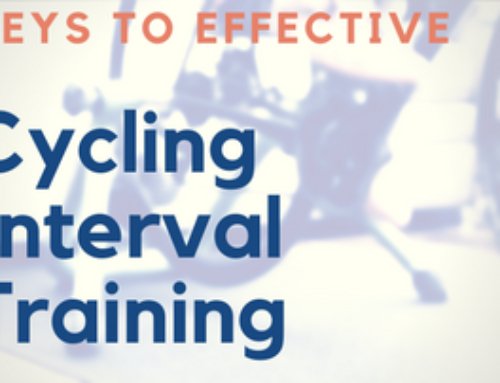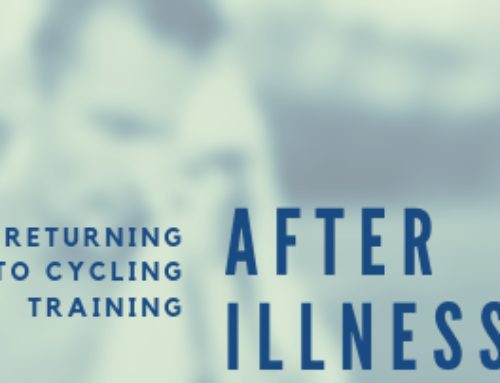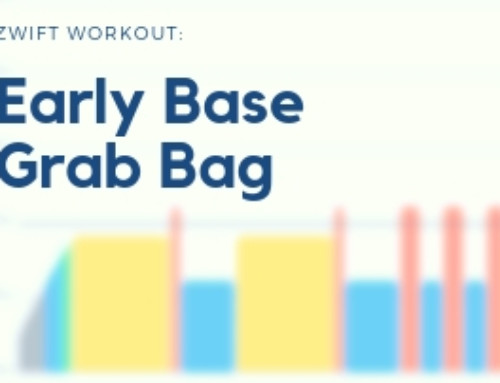One of the most efficient ways of kick starting your fat burning metabolism and boosting your cycling fitness is to partake in fasted training. As I've talked about before, your body is designed to utilize the energy substrates that are available to it to meet energy demands. During fasted exercise, there’s a stark limit on the amount of sugar available. There is, however, a huge amount of energy available from fat stores, and you need to train your body to use it effectively.
Similar to how your body will adapt to exercise by getting fitter, your body will adapt to fasted training by increasing the amount of fat it can burn. Fasted training helps to adapt your body to the stresses of hard training and primes you for a “train low, compete high” scenario where you’ll teach your body to be stingy in burning carbs in your typical training but supply it more on race day to ensure it's properly fueled. This will not happen overnight, though. It will take months of work to increase the efficiency of your body’s fat burning machinery, and these fasted training tips will give you a significant edge in that quest.
As you start your fasted training protocols, keep in mind a couple of simple things:
- Always carry some food with you to prevent bonking (and be prepared to eat after an hour of hard riding)
- If you’re not feeling well or having an off day, skip the fasted training and eat something. You can always go back to it later in the week.
- Pay careful attention to your body: if you start to bonk badly or repeatedly, back down and rest a bit, and be sure to eat.
Bearing those “safety” concepts in mind, click through the jump to learn how to add fasted training to your cycling program.
 Nutritional notes and considerations
Nutritional notes and considerations
Fasted training can be full of pitfalls if you're not careful. Among them are bonking and muscle catabolism, which you'll want to avoid at all costs. Additionally, you can stimulate some of these fat burning adaptations by modifying your diet to stimulate your body's fat burning machinery.
To prevent bonking, you'll want to carry some food in your pockets with you while you're training. Typically you have between 60 and 90 minutes of glycogen stored in your muscles and liver, and that's usually enough to handle a fasted training session. However, sometimes you just haven't recovered well from a previous effort or you push well beyond what you're capable of. A banana, bar or gel in your back pocket will ensure you don't hit the wall before you've hit your front door.
Avoiding muscle loss is also a valid concern when performing fasted training intervals. You can stave off muscle loss with pre and post workout protein supplementation (such as a
Nutritionally, you can stimulate β-oxidation with fat prior to training by ingesting fat. Ingesting fatty acids (such as those found in the butter and MCT oil in a Bulletproof Coffee) does a couple of specific things. A fatty meal will stimulate hormone sensitive lipase, and it will increase fat to carbohydrate ratio in the blood stream. This change in fat/carbohydrate ratio will stimulate glucagon and stimulates protein kinase A. These, in turn, lead to phosphorylation of perilipin, expose the fat cell to the hormone-sensitive lipase and cause it to release free fatty acids. Those free fatty acids are then used to fuel your workout.
Finally, caffeine stimulates fat metabolism by sparing glycogen stores in muscle tissue at sub-threshold levels. It acts at several points in the citric acid cycle to stimulate fatty acid usage and help to spare glycogen in the cell by creating additional sources of Acetyl-CoA and Citrate. So that pre-ride cup of coffee may be a way to stimulate your fat burning machinery.
Your first month of fasted training
If you’ve been following any kind of higher fat diet, you’ll have a little bit of a physiological advantage since your body will have been ramping up your fat burning machinery already. But this doesn’t mean your body is used to exercising in a fasted state; far from it. Exercise requires significantly more energy expenditure than simply sitting at a desk or working behind a computer. To ask your body to go from zero to one hundred without giving it some baby steps along the way is a recipe for disaster.
For that reason, during the first month of your fasted training program, you’ll want to start off nice and easy. I’d recommend you only perform one day of fasted training every week during the first month of your training schedule. This may not sound like much, but once you get out there (or on the trainer) and you start going at it, you’ll realize that it may be a little more of a shock than you would expect.
Typically, the best workout to perform during this first month of fasted training will be your easiest day. I’ll even go so far as recommend that your very first fasted workout be a recovery ride. Why? Isn’t a recovery ride supposed to help you recover from harder workouts? Yes, it is. But it’s also a chance to get some effective training done on your fat burning machinery. Since much of your energy during a recovery ride is coming from fat stores anyway, it’s the perfect opportunity to help push that physiology a little bit further without adding a lot of training stress to your body or forcing it into an anaerobic state with little circulating blood sugar to spare.
Following your very first workout, you’ll want to perform the next three weeks of fasted workouts on your easiest training day. This would not be your recovery day, but would be a day you’re performing primarily aerobic work such as neuromuscular drills, speed drills or other aerobic, technique-driven work. When performing these drills, you should be primarily utilizing aerobic energy pathways, so limiting the amount of carbohydrate available to them during activity will help to increase your body’s ability to break down and use fat as fuel.
A nifty side effect of this is your easy training day also becomes a big fat burning day. Imagine if you can spend most of your ride burning fat? Not only will you be fresher at the end of the ride, you’ll be lighter in the long run as you melt off pounds.
Your second month of fasted training
After a month of once-per-week fasted workouts, you’re ready to start ramping things up a little bit and challenging your body a little bit more. In the second month of your quest to become a fat burning cyclist, you’re going to aim to do two fasted workouts per week. Assuming you’re riding your bike four days per week, this means you’re going to be doing fully half of your days as fasted workouts. You’ll want to give at least a couple days of “recovery” in between these fasted workouts, and I generally recommend doing every other workout without eating before hand.
Which two workouts will you want to do without food? You’re going to be sticking to your easiest days once again. Anything that involves you doing primarily aerobic work such as neuromuscular drills, speed drills or specific technique work is a perfect example of a fasted workout day. Where this starts to become a problem is when you’re riding less than four days per week OR you’re doing a lot of higher intensity, harder efforts (such as during a peak phase.)
In these cases, you have a couple of options. My recommendation is to do as much aerobic work as you can in those two fasted days, and even break your days into doubles if you have to. Do the aerobic portion of your workout in the morning in a fasted state (even if it’s only 30-45 minutes) and then do your interval work in the afternoon or evening. You can even do your fasted workout in the early morning, then chow down on a light breakfast before returning to your bike half an hour later to finish your higher intensity intervals.
One secret that I use when directly coaching athletes: I’ll start directing my athletes to do one day of sweet spot level training (usually of the muscular endurance type) for their fasted workout. This is a perfect way to get them to slowly ramp up the intensity, challenge their body to really start churning out some energy from their fat stores and build a little bit of fundamental fitness in the process. This slightly higher intensity will really ramp up that AMP Kinase enzyme (which drives mitochondrial density changes), leading to some significant increases in b-oxidation of fat and increases in mitochondrial density.
 Your third month of fasted training
Your third month of fasted training
The third month of your fasted training will be basically the same as the second month of fasted training. You’ll continue to perform two fasted training sessions per week, generally on your easy days. As you progress through this month, you can experiment with adding more sweet spot training to your fasted workouts. Continue monitoring your body and adjusting your training as necessary by adding more intensity: if you're getting through your workouts fine and feeling like you've got something left, start adding some extra intensity. If you find you’re bonking hard during workouts, you may need to turn down the intensity a little bit or consider adding a very small amount of carbohydrate during your workout to stave off central governor fatigue (your brain and central nervous system requires carbohydrates for fuel, so part of fatigue in a fasted state is due to carbohydrate depletion).
At this point, when I’m coaching an athlete on a fasted training protocol, I do start to add smaller amounts of threshold work to their fasted workouts. Again, this forces the body out of its comfort zone and into new territory that it hasn’t explored before. That shift out of your body’s comfort zone is what forces it to adapt, and adding fat adapted threshold work will certainly push your physiology beyond any place it’s been before.
Another trick I use is to have the athlete complete fasted work on back-to-back days. Just like stacking up training stress with back-to-back workouts, you’ll stack up fat adaptation as well. You’ll have to be careful with these, though, as the temptation to overdo it is very high and the potential for disastrous bonking is real.
Your fourth month of fasted training
During the fourth month of your fasted training program, it’s going to be time to throw down. You’re going to challenge your body’s ability to perform under high intensity while still generating a significant portion of the energy needed from fatty acids. These will probably be some of the hardest intervals you’ll be taking on, and you’ll be exceeding your threshold without much glucose with which to do so. Expect to have a tough time with these intervals initially, and remember that you'll want to be carrying some kind of nutrition with you to ensure you're not stranded somewhere.
In this phase of fasted training, you’ll continue to do two days of fasted workouts. You’ll still generally want your fasted workouts to be every other workout because one of these fasted training sessions will be a hard day and the other will be an easy day (just like before.) Now, we're talking about a “hard day”, you’ll be doing high-intensity interval work in a fasted state, which will turn the screws on your fat burning metabolism. The targets of these high-intensity intervals are β-oxidation pathways, stimulation of AMP Kinase to build more mitochondria, and stimulate the Cori Cycle, which will force the body to metabolize lactic acid into glucose via gluconeogenesis.
Training these enzymes and pathways will increase the percentage of your threshold where you burn fat as a primary fuel. This spares glycogen for the supra-threshold efforts that win a race. As I've talked about before, there’s no strict cutoff as to when the body switches from fat metabolism to carbohydrate metabolism, and these hard efforts are designed to shift the break point where your body starts eating up carbs for energy to a higher intensity.
To safely perform these hard intervals in a fasted state, you’ll need to keep in mind the tips I provided earlier in this post. If you really start to bonk, then you need to eat. Period. There’s no question about that. You can refer to the phrase “if you’re burning sugar, you need to take in some sugar” any time you’re not sure if you should eat. Why is that the case? Aren’t we trying to burn fat by reducing the amount of carbohydrate our body has to burn?
Quite simply, your brain still needs sugar to function (about 25% of its calories need to come from carbohydrates) and if you burn up all of those carbs in your zone 5, 6 or 7 work, you’re going to be in a world of hurt. Your body will enter a state of “emergency” glycogen sparing where it begins to shut down exercising muscles in order to save any remaining glucose for the brain. This is why you bonk, and it’s why you get that tunnel vision and “blackout” feeling.
Don't get to that point.
Fasted training beyond 4 months
After four months of fasted training and interval work, your body will have been pretty well adapted to burning fat for fuel. You'll likely end up training in a fasted or semi-fasted state once in a while, but you'll still need to maintain those adaptations by doing some specific fasted training once in a while. Typically, I recommend competitive riders train in a fasted state once every 10 days or so, just to “beef up” the machinery a little bit. If you're simply a recreational rider looking to trim some pounds, you can get away with a couple sessions per month.
With that information in your back pocket, what are you waiting for? When are YOU going to start your fasted training program and watch the pounds melt off?





